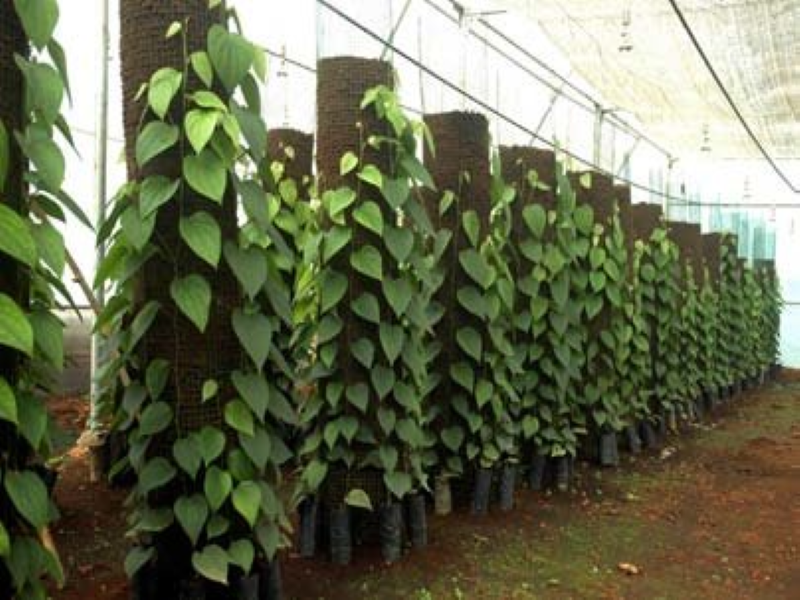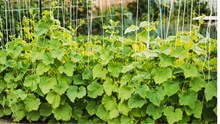
Pepper cultivation plays a key role in India's exports. It is cultivated in Kerala, Karnataka and Tamil Nadu. In Nature, agricultural practices pepper can be cultivated as main crop as well as intercrop with inputs from the harvested crop to be grown up to 25 m apart. In Sloping areas take necessary precautions to prevent drainage of chemical cultivation land water into nature agriculture land.
Pepper prefers a light porous and well-drained soil rich in organic matter. Water stagnation in the soil, even for a very short period, is injurious for the plant. So, heavy textured soils in locations where drainage facilities are inadequate should be avoided.
Flags should be planted at a spacing of 10 X 10 feet on flat areas, 12 feet between rows and 8 feet between rows on sloping areas. Flags should be flown as high as possible. Some varieties of pepper are available in shade only clear area/shade and clear area only, growing and producing varieties. However, replacing varieties that produce only in the shade will result in proper production in a well-lit place for others. The root system of any plant grows properly when exposed to direct sunlight. Getting the product right
Pepper prefers a light porous and well-drained soil rich in organic matter. Water stagnation in the soil, even for a very short period, is injurious for the plant. So, heavy textured soils in locations where drainage facilities are inadequate should be avoided.
As the plant grows, it should be tied up and transplanted. Weeds in the garden should be removed in a timely manner. Watering small young vines in summer is good for survival and growth in summer. Irrigation of fruit-bearing plants at intervals of 10-12 days from December to late March is good for crop growth. At the beginning of the rainy season, the shade of the flag garden should be adjusted. The wood can be used to mulch the flag.
Pepper is a crop that requires a lot of nutrients. At the beginning of the monsoon season (April-May) lime should be added to the flagpole on the basis of the soil test. Depending on the size of the flag, sufficient poultry and neem cake may be provided at the beginning of the rainy season. Apply neem cake along with organic manure at the beginning of spring. At least one and a half feet from the vine, take small trenches inside and cover it with manure. Care should be taken not to damage the roots when taking trenches. In addition to organic manure, one and a half kg of NPK (NPK) should be applied four times depending on the size of the flag (for flags less than 25 feet in size and less than 5 kg of dried chillies)

The plants bloom in early June. In non-rainy areas, watering of the plant is very good every day. Any kind of pollination is possible through wind and water. If the tide is long enough, the best watering is done in rainy weather, with water available at the base every day.
At the beginning of the rainy season and before the monsoon, spray the plants with Bordeaux mixture at the rate of 1 per cent and pour copper oxychloride (2 g/litre) at the bottom. Alternatively spraying 0.3 per cent potassium phosphonate on the plants and pouring at the bottom can protect the plants from diseases to some extent.
Quick Wilt
The disease is most severe during the monsoon season. Infection can occur on any part of the plant. The black spots on the leaves are gradually spreading around. Then the leaves fall off. The disease reaches the flag through the scab that spreads through the bottom and through the root chamber. When the infected part of the main stem of the flag is infected, the branches and eye branches fall over the knee, causing the flag to collapse altogether.
If the disease affects only the root, the flag may die in one or two years with the symptoms of jaundice, gastrointestinal disturbance, leaf fall and biting at the time of rain. Root and destroy the infected flag and burn it. Collect planting material from the disease-free garden. Install drainage system in the garden. Do not damage the root of the vine by stirring. Avoid sprinkling in the soil during rainy season by mulching at the bottom or growing a mantle crop. Spray Bordeaux mixture at 1% strength on the flags before rain. Spray Bordeaux mixture again after 45 days. The soil should be soaked by pouring 0.2% copper oxychloride on the roots before and after rains. Put the neem cake on the flagpole.
Thrips
The attack on thrips is more common in young vineyards. Adult thrips are black. Due to the infestation of leafhoppers and leafhoppers, the edges of the leaves curl back inwards and lose their shape. It significantly affects the growth of the flag. Diphtheria 0.05 per cent can be sprayed to kill the thrips. If new leaves appear again after spraying, spray again within 20 days.
Viral Infection / Leaf Stunting
Unlike normal leaf growth, the leaves lose their shape and curl, with yellowing of the leaves, shortening of the leaves and yellow spots on the leaves. Total vines are stunted and production is reduced. These plants should be uprooted and set on fire.
The disease is spread by producing seedlings with infected vines. These should be controlled by spraying with dimethoate and monocrotophos. If the seedlings are placed in the nursery, the fishes will suddenly multiply. Aphids and mites should be controlled by spraying the same drug in the nursery.
Stem Borer
Moths attack the young flags. Their attack is exacerbated during the monsoon season when young twigs appear. The larvae that hatch on the stem and hatch into the pods, break through the tip of the young twigs and devour the mush, which gradually withers and decays. As the attack intensifies, the vine grows stunted. The quinoa phosphorus (Ecolus) can be rescued by boiling the plant's head at least once a month in 2 ml / 1-litre water during the growing season.
Moth infestation
It looks like white cotton which is a major problem in pepper orchards. These pests, which mainly attack the roots of the vine, cause yellowing of the plant by sucking the sap of the plant and destroying the plant. The months of February and May are the hottest months. They are found on stalks and leaves of plants during hot weather. It is carried to plants by ants, such as water. You can control ants by mixing Marotti oil with water. To control weevils at the roots of the vine, chlorpyrifos can be mixed with 2 ml / 1 litre of water and poured on the flagpole and sprayed on the plant if it is found above the soil surface.















